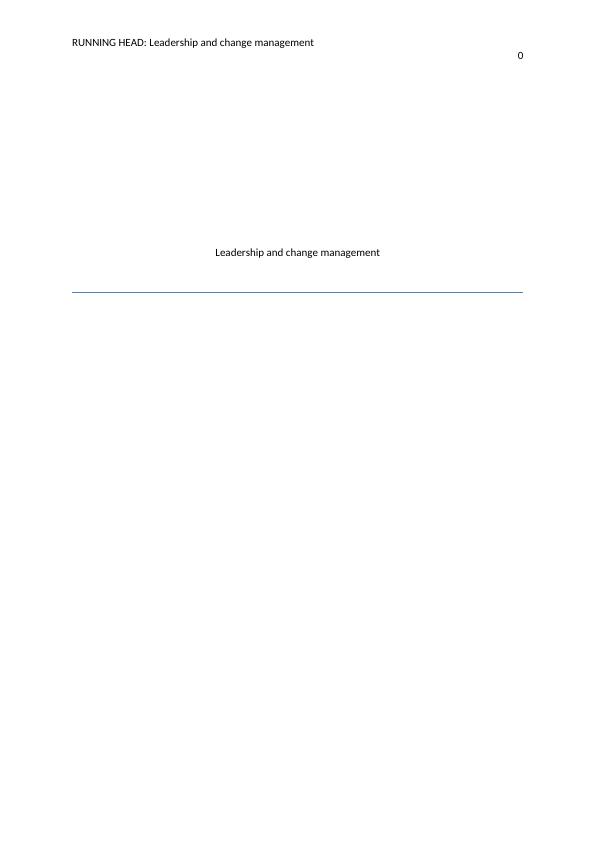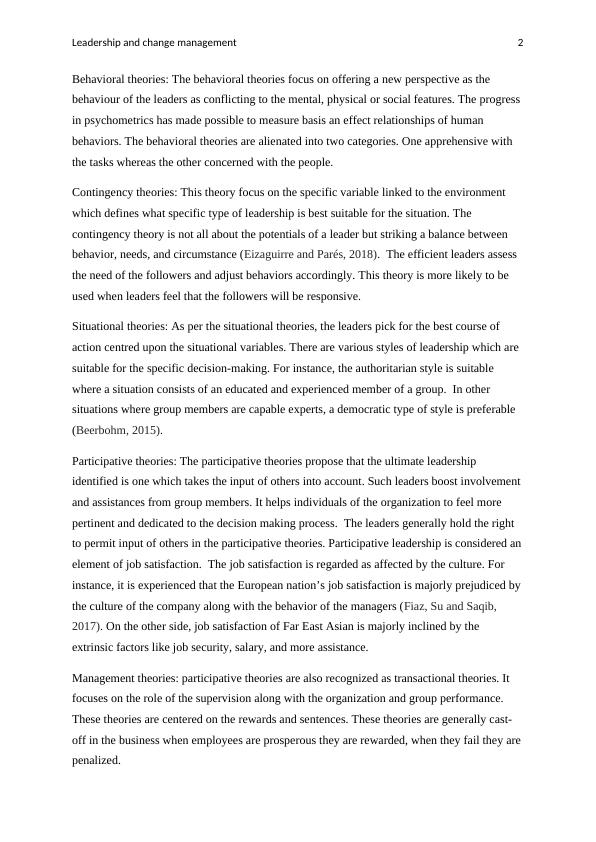Leadership and Change Management: Impact on Employee Job Satisfaction and Organizational Obligation in the Construction Sector of UAE
Added on 2023-06-11
8 Pages2712 Words376 Views
RUNNING HEAD: Leadership and change management
0
Leadership and change management
0
Leadership and change management

Leadership and change management 1
According to Kim and Maubourgne (1992), Leadership is identified as the capability to
inspire confidence and assist people who are required to attain organizational goals. The
leadership is a process which maximizes the efforts towards attainment of the goals (Kim and
Maubourgne, 1992). The leadership is an addition of considering leadership behaviors and
outlook. A leader can be effective in one situation but do not necessarily to be effective in all
the situations. The different type of leadership is adopted for a different situation. Each leader
should know when to display a specific approach. The course of action provides detailed
information about the background of the study. This paper aims to define different leadership
styles put an impact on the employee job satisfaction and organizational obligation in the
construction sector of the UAE. The factors considered as determinants of leadership style
are:
The level in the authority hierarchy
Function and scope of the administrative unit
Task characteristics and expertise
Crisis situation
Lateral interdependence
Phases in the business life cycle
Subordinate’s capability and enactment
There are different theories of leadership are emerged which can be classified as:
Great man theories: According to Randeree and Ghaffar Chaudhry, 2012, great leaders are
born with certain inherent characteristics like charisma, self-reliance, social skills and
aptitude which make natural-born leaders. The great man theory views that capacity for the
leadership is inherited by the leaders, not made. This theory believes that an individual cannot
learn how to become strong leaders. It is something which a person is born with or without
(Randeree and Ghaffar Chaudhry, 2012).
Trait theories: The trait theories accept that people succeed to specific qualities and
individualities which make them better apposite to the leadership. This theory recognizes a
particular personality or individualities shared by the individuals. For instance, the traits like
self-confidence, courage, and extroversion are possibly associated with the great leaders. The
trait theory concentrates on evaluating mental, physical and social appearances to gain an
understanding of the combination of characteristics (Woods, 2016).
According to Kim and Maubourgne (1992), Leadership is identified as the capability to
inspire confidence and assist people who are required to attain organizational goals. The
leadership is a process which maximizes the efforts towards attainment of the goals (Kim and
Maubourgne, 1992). The leadership is an addition of considering leadership behaviors and
outlook. A leader can be effective in one situation but do not necessarily to be effective in all
the situations. The different type of leadership is adopted for a different situation. Each leader
should know when to display a specific approach. The course of action provides detailed
information about the background of the study. This paper aims to define different leadership
styles put an impact on the employee job satisfaction and organizational obligation in the
construction sector of the UAE. The factors considered as determinants of leadership style
are:
The level in the authority hierarchy
Function and scope of the administrative unit
Task characteristics and expertise
Crisis situation
Lateral interdependence
Phases in the business life cycle
Subordinate’s capability and enactment
There are different theories of leadership are emerged which can be classified as:
Great man theories: According to Randeree and Ghaffar Chaudhry, 2012, great leaders are
born with certain inherent characteristics like charisma, self-reliance, social skills and
aptitude which make natural-born leaders. The great man theory views that capacity for the
leadership is inherited by the leaders, not made. This theory believes that an individual cannot
learn how to become strong leaders. It is something which a person is born with or without
(Randeree and Ghaffar Chaudhry, 2012).
Trait theories: The trait theories accept that people succeed to specific qualities and
individualities which make them better apposite to the leadership. This theory recognizes a
particular personality or individualities shared by the individuals. For instance, the traits like
self-confidence, courage, and extroversion are possibly associated with the great leaders. The
trait theory concentrates on evaluating mental, physical and social appearances to gain an
understanding of the combination of characteristics (Woods, 2016).

Leadership and change management 2
Behavioral theories: The behavioral theories focus on offering a new perspective as the
behaviour of the leaders as conflicting to the mental, physical or social features. The progress
in psychometrics has made possible to measure basis an effect relationships of human
behaviors. The behavioral theories are alienated into two categories. One apprehensive with
the tasks whereas the other concerned with the people.
Contingency theories: This theory focus on the specific variable linked to the environment
which defines what specific type of leadership is best suitable for the situation. The
contingency theory is not all about the potentials of a leader but striking a balance between
behavior, needs, and circumstance (Eizaguirre and Parés, 2018). The efficient leaders assess
the need of the followers and adjust behaviors accordingly. This theory is more likely to be
used when leaders feel that the followers will be responsive.
Situational theories: As per the situational theories, the leaders pick for the best course of
action centred upon the situational variables. There are various styles of leadership which are
suitable for the specific decision-making. For instance, the authoritarian style is suitable
where a situation consists of an educated and experienced member of a group. In other
situations where group members are capable experts, a democratic type of style is preferable
(Beerbohm, 2015).
Participative theories: The participative theories propose that the ultimate leadership
identified is one which takes the input of others into account. Such leaders boost involvement
and assistances from group members. It helps individuals of the organization to feel more
pertinent and dedicated to the decision making process. The leaders generally hold the right
to permit input of others in the participative theories. Participative leadership is considered an
element of job satisfaction. The job satisfaction is regarded as affected by the culture. For
instance, it is experienced that the European nation’s job satisfaction is majorly prejudiced by
the culture of the company along with the behavior of the managers (Fiaz, Su and Saqib,
2017). On the other side, job satisfaction of Far East Asian is majorly inclined by the
extrinsic factors like job security, salary, and more assistance.
Management theories: participative theories are also recognized as transactional theories. It
focuses on the role of the supervision along with the organization and group performance.
These theories are centered on the rewards and sentences. These theories are generally cast-
off in the business when employees are prosperous they are rewarded, when they fail they are
penalized.
Behavioral theories: The behavioral theories focus on offering a new perspective as the
behaviour of the leaders as conflicting to the mental, physical or social features. The progress
in psychometrics has made possible to measure basis an effect relationships of human
behaviors. The behavioral theories are alienated into two categories. One apprehensive with
the tasks whereas the other concerned with the people.
Contingency theories: This theory focus on the specific variable linked to the environment
which defines what specific type of leadership is best suitable for the situation. The
contingency theory is not all about the potentials of a leader but striking a balance between
behavior, needs, and circumstance (Eizaguirre and Parés, 2018). The efficient leaders assess
the need of the followers and adjust behaviors accordingly. This theory is more likely to be
used when leaders feel that the followers will be responsive.
Situational theories: As per the situational theories, the leaders pick for the best course of
action centred upon the situational variables. There are various styles of leadership which are
suitable for the specific decision-making. For instance, the authoritarian style is suitable
where a situation consists of an educated and experienced member of a group. In other
situations where group members are capable experts, a democratic type of style is preferable
(Beerbohm, 2015).
Participative theories: The participative theories propose that the ultimate leadership
identified is one which takes the input of others into account. Such leaders boost involvement
and assistances from group members. It helps individuals of the organization to feel more
pertinent and dedicated to the decision making process. The leaders generally hold the right
to permit input of others in the participative theories. Participative leadership is considered an
element of job satisfaction. The job satisfaction is regarded as affected by the culture. For
instance, it is experienced that the European nation’s job satisfaction is majorly prejudiced by
the culture of the company along with the behavior of the managers (Fiaz, Su and Saqib,
2017). On the other side, job satisfaction of Far East Asian is majorly inclined by the
extrinsic factors like job security, salary, and more assistance.
Management theories: participative theories are also recognized as transactional theories. It
focuses on the role of the supervision along with the organization and group performance.
These theories are centered on the rewards and sentences. These theories are generally cast-
off in the business when employees are prosperous they are rewarded, when they fail they are
penalized.

End of preview
Want to access all the pages? Upload your documents or become a member.
Related Documents
Leadership Theorieslg...
|5
|1056
|51
Leadership Theorieslg...
|5
|1050
|22
Leadership in Business - Assignment Solvedlg...
|8
|3025
|22
Managing Organizations and Leading Peoplelg...
|5
|911
|297
Traits and Behaviors of Early Leadership Theorieslg...
|8
|1664
|359
The Assignment on Organizational Behaviourlg...
|8
|2080
|34
